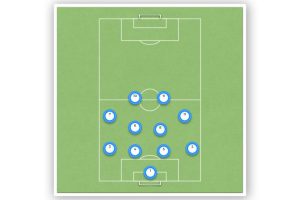Mastering Midfield Play: How to Dominate with the Diamond Formation in Soccer
The diamond formation is a popular soccer formation that has been used by many successful teams to dominate midfield play. The formation is characterized by a diamond shape in the midfield, with one defensive midfielder at the base, two central midfielders on each side, and an attacking midfielder at the tip of the diamond. This formation offers a number of advantages, including increased possession, better control of the midfield, and more attacking options.
Using the diamond formation effectively requires a good understanding of the roles and responsibilities of each player. The defensive midfielder is responsible for protecting the back line and breaking up opposition attacks, while the central midfielders are tasked with controlling the midfield and distributing the ball to the attacking players. The attacking midfielder is the creative force in the team, responsible for creating chances and linking up with the forwards.
In this article, we will explore how to use the diamond formation to dominate midfield play in soccer. We will look at the key principles of the formation, the roles and responsibilities of each player, and some tips and tactics for using the formation effectively. Whether you are a coach looking to implement the diamond formation with your team or a player looking to improve your understanding of the game, this article will provide you with the knowledge and tools you need to succeed.
Understanding the Diamond Formation
The diamond formation is a popular soccer formation that is known for its ability to dominate midfield play. It is a versatile formation that can be used to create a strong defense and an effective attack. Understanding the basics of the formation and the roles and responsibilities of each player is crucial for success.
Formation Basics
The diamond formation is a 4-4-2 formation with a diamond-shaped midfield. The formation consists of four defenders, four midfielders, and two forwards. The midfielders are arranged in a diamond shape, with one defensive midfielder at the base of the diamond, two central midfielders on either side, and one attacking midfielder at the top of the diamond. The two forwards play up front and are supported by the midfielders.
The diamond formation is a compact formation that allows for quick transitions between defense and attack. The formation is also flexible, allowing for adjustments based on the opponent’s tactics.
Roles and Responsibilities
Each player in the diamond formation has specific roles and responsibilities that are crucial for success. The roles and responsibilities are as follows:
- Goalkeeper: The goalkeeper is responsible for protecting the goal and initiating attacks from the back.
- Defenders: The defenders are responsible for marking the opposing team’s forwards and preventing them from scoring. They also initiate attacks from the back.
- Defensive Midfielder: The defensive midfielder is responsible for protecting the defense and breaking up the opposing team’s attacks. They also initiate attacks from the back.
- Central Midfielders: The central midfielders are responsible for controlling the midfield and distributing the ball to the forwards. They also provide support to the defense and attack.
- Attacking Midfielder: The attacking midfielder is responsible for creating chances for the forwards and scoring goals. They also provide support to the midfield and defense.
- Forwards: The forwards are responsible for scoring goals and creating chances for themselves and their teammates. They also provide support to the midfield.
Each player’s role is crucial for the success of the team. The defensive midfielder is the key player in the formation, as they provide cover for the defense and initiate attacks from the back. The attacking midfielder is also an important player, as they create chances for the forwards and score goals.
Dominating Midfield Play with the Diamond Formation
The diamond formation in soccer is a popular tactical approach that can help teams dominate midfield play. By using this formation, teams can control possession, exploit the flanks, and create overloads in the center of the field. In this section, we will discuss how to use the diamond formation to dominate midfield play in soccer.
Using the Formation to Control Possession
One of the primary benefits of the diamond formation is its ability to control possession. The formation features a tight midfield diamond, with a defensive midfielder at the base, two central midfielders on the sides, and an attacking midfielder at the tip of the diamond. This setup allows for quick and efficient passing, with players able to find each other easily and maintain possession.
Teams using the diamond formation should focus on keeping the ball moving and looking for opportunities to advance the play. The defensive midfielder should be responsible for breaking up opposition attacks and starting the team’s own attacks from deep. The central midfielders should look to control the tempo of the game and keep the ball moving, while the attacking midfielder should be creative and look for opportunities to play through balls and create chances for the team’s forwards.
Exploiting the Flanks
While the diamond formation is primarily focused on controlling the center of the field, it can also be used to exploit the flanks. The two wide midfielders in the diamond formation have an important role to play in this regard. They should be constantly looking to get forward and provide support to the team’s wingers and fullbacks.
Teams using the diamond formation should look to switch the play quickly and use the wide midfielders to stretch the opposition defense. This can create space in the center of the field for the team’s forwards to exploit, while also giving the team more options in attack.
Creating Overloads in the Center
One of the key advantages of the diamond formation is its ability to create overloads in the center of the field. With four midfielders in a tight diamond, teams can overwhelm opposition defenses and create space for their forwards to exploit.
Teams using the diamond formation should focus on quick passing and movement to create these overloads. The attacking midfielder should look to drop deep and create a numerical advantage in midfield, while the central midfielders should look to make runs into the opposition box to create chances for themselves and their teammates.
The diamond formation is a versatile and effective tactical approach that can help teams dominate midfield play in soccer. By using this formation to control possession, exploit the flanks, and create overloads in the center of the field, teams can create more chances and score more goals.
Training and Drills
Training and drills are essential to master the diamond formation and dominate midfield play in soccer. Here are some position-specific drills and team drills that can help players understand their roles and responsibilities in the diamond formation.
Position-Specific Drills
Position-specific drills are designed to help players understand their roles and responsibilities in the diamond formation. Here are some drills for each position:
- Goalkeeper: Work on positioning, communication, and distribution. Use drills that simulate game situations, such as dealing with crosses, making saves, and playing out from the back.
- Center Backs: Work on defending, marking, and distribution. Use drills that simulate game situations, such as 1v1 defending, covering for each other, and playing long balls.
- Defensive Midfielder: Work on screening the defense, intercepting passes, and distributing the ball. Use drills that simulate game situations, such as pressing, tackling, and playing short passes.
- Attacking Midfielder: Work on creating chances, linking up with the forwards, and finishing. Use drills that simulate game situations, such as dribbling, passing, and shooting.
- Forwards: Work on scoring goals, holding up the ball, and creating space for others. Use drills that simulate game situations, such as finishing, making runs, and playing combinations.
Team Drills
Team drills are designed to help players understand how to work together as a unit in the diamond formation. Here are some drills that can help:
| Drill | Description |
|---|---|
| Midfield Diamond | Set up a small-sided game with a diamond midfield. The red team has the diamond formed and works the ball back and forth to the endline players on red (4 players – 2 on each side). The blue team has three defenders and two forwards. The objective is for the red team to keep possession and create scoring opportunities. |
| Switching Play | Set up a small-sided game with a diamond midfield. The objective is for the team in possession to switch the ball quickly from one side of the field to the other, using the diamond to create passing angles and space. The defenders must try to intercept or block the passes. |
| Counter-Attacking | Set up a small-sided game with a diamond midfield. The objective is for the team out of possession to win the ball and quickly counter-attack, using the diamond to create passing angles and space. The defenders must try to recover and stop the attack. |
Advanced Tactics and Adjustments
While the diamond formation can be a dominant force in midfield play, it is important to have a few advanced tactics and adjustments in your arsenal to stay ahead of the competition.
Switching to a Flat Midfield
One adjustment that can be made is switching from the diamond to a flat midfield. This can be useful when facing a team that is overloading the wings or when the diamond is not working effectively. The flat midfield can provide more width and stability in defense, while still maintaining control of the midfield.
When switching to a flat midfield, the two wide midfielders move out to the wings to provide width, while the central midfielders drop deeper to provide cover in front of the defense. The striker may also drop deeper to support the midfield and link up play.
Counterattacking with the Diamond
Another advanced tactic is using the diamond formation for counterattacking play. The diamond can be effective in quickly transitioning from defense to attack, as the central midfielders are already in position to launch a quick attack.
When counterattacking with the diamond, the team may look to quickly play the ball forward to the striker or wide players, who can then look to play a quick one-two with the central midfielders to break through the opposition defense. The fullbacks can also provide support in attack, with the defensive midfielder dropping back to provide cover.
It is important to note that when using the diamond for counterattacking play, the team must be quick and decisive in their decision-making and passing, as any hesitation can allow the opposition defense to regroup and nullify the attack.







